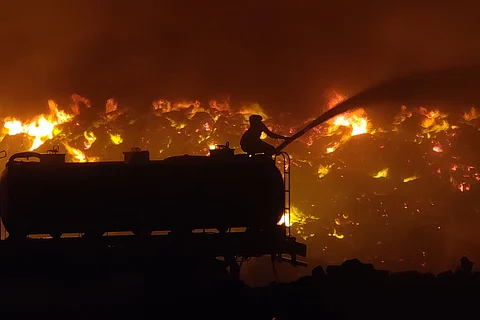

A coconut and wood waste processing facility sits on the edge of Chennai’s 225-acre Perungudi landfill — the site of a three-day fire that engulfed the neighbourhood in smoke and the stench of burning rubbish. Firefighters were seen battling the smoke, summer heat, and the methane pockets formed due to the waste buried deep underground, to douse the flames. Dry coconut husks arrive at this facility, operated by Westart Communications India Private Limited, via the Greater Chennai Corporation (GCC). The husks are used to produce coco pith, used widely in gardening, and fibre which can be used to make coir ropes, bed fillings, etc. Besides this, logs from trees felled by the GCC are converted into wood chips to produce briquettes on the site. This means three easily flammable items are being produced at a facility bordering the landfill. A visit to the site did not reveal the implementation of any necessary safety provision, from what little TNM was allowed to see.
At the site, TNM spoke to workers and others about the blaze. A man in a small office at the entrance confirmed that this was indeed the place where the fire broke out. One of the supervisors he pointed us to was more wary of confirming or denying the same, but he explained the work being carried out at the facility. “The husks are turned into coco pith and coir. The pith is quite popular with plant nurseries. They buy them directly from the facility by weight. The wood chips are converted into briquettes. These are particularly useful as fuel for factory broilers,” said the supervisor, adding that briquettes burn at a higher temperature than wood.
Westart leases the grounds from the GCC and has the tender for the recycling efforts carried out on the premises. The facility comprises a large shed, open on the sides, housing various machines. Sacks of briquettes are piled to one side of this shed. A few feet away, a long pile of wood chips can be seen roughly five to six feet high. This is the ground zero of the fire, said a fireman who was one of the first respondents on April 27, when the blaze started. Incidentally, the supervisor mentioned that the machines have not been running since that date. Behind the shed is a flattened stretch of land, spanning a distance of about 130 to 150 metres, littered with rubbish, residual ash and burn marks on the ground. Parked at a distance is a solitary bright red engine. “On the day of the fire, you would not have recognised this spot,” said the fireman. “Piles of logs stood at about the height of a fire truck. They were all ablaze. The fire started at that wood chip pile. As I understand, they tried to bring it under control, but sparks flew towards these logs and they caught on fire. We had to stop the truck near the spot where the wood chip pile begins. The vehicle could not move any further.”
A solitary bright red truck parked near the site where the fire is suspected to have begun
The recycling facility shed | Special arrangement
A top source from the Tamil Nadu fire department confirmed to TNM that the fire had started at this facility run by Westart. Such facilities are not reviewed for fire safety because they are located within a landfill, the official said. That, coupled with summer heat and the absence of a proper waste segregation process in the landfill, vastly increases the likelihood of fires breaking out here, the official added.
However, a chief engineer from the GCC, denied that the said processing facility was the source of the fire. “Legacy waste that is 30 to 35 years old has accumulated nearby. This is what caught fire first. The fire then reached some parts of the coconut and wood waste processing facility, before spreading into the landfill. It is natural for fires to start in such landfills in the summer due to the heat and the presence of methane pockets. It is happening in other parts of the country as well, such as in New Delhi.” When it was pointed out that, regardless, the material at the facility is flammable, he said the facility was equipped with five fire hydrants. A water lorry is stationed at the facility at all times during the summer, he added. TNM, however, did not see such a lorry or the hydrants when we visited the site.
The wood chip pile is now covered in sand, but it wasn’t like that on that day, the fire man told TNM. “They have covered it up now.” Whatever debris the fire would have left is mostly cleared away too, though remnants remain. With no perceivable buffer between the logs and the piles of garbage, the fire likely spread further, into the sprawling landfill that has already been a source of many environmental concerns for years.
The area where the wood pile was stocked has now been cleared
Plumes of smoke emanate from the site of the fire | Special arrangement
Down the road from this facility, portions of the original Pallikaranai marshland attempt to peek out from between foetid garbage heaps and weeds. A pool of water that flows towards the main road from inside the landfill is a lurid pink. Inside the landfill too, the pink-coloured water is most stark at where the water’s edges meet the hillocks of rubbish. The tilt of the land seems to be moving the water towards the road. The situation begs the question: what from these piles of waste is changing the water so drastically? Environmentalist Nityanandan Jayaraman tells us that the colour is likely due to the presence of cyanobacteria in the water, a sure indicator of severe pollution.
A pool of water that flows towards the main road from inside the landfill is a lurid pink